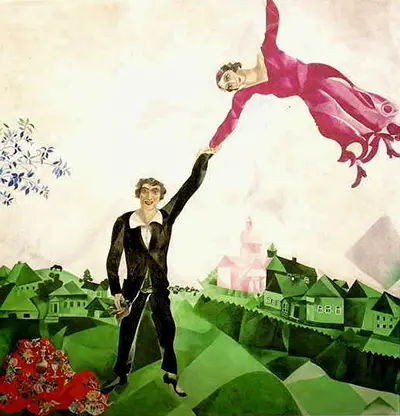They, and Chagall himself, would surely be glad that one of his most well-loved and most frequently reproduced paintings dates from one of the happiest times of his life.
Chagall first met his future wife, Bella Rosenfeld, when he was working and studying with the painter and theatrical designer Leon Bakst.
For the following 35 years, until her death during their wartime exile in the United States, she would be an intensely powerful and positive influence on his development as an artist. Later in life, he would stress her presence in his creative imagination, long after losing her: "She has flown over my pictures for many years, guiding my art."
The couple married in 1915 and their daughter, Ida, was born the following year. Despite the upheaval of war and revolution in the former Russian Empire, this was a happy time: the 30-year-old Chagall, having earned some critical recognition in Paris and for his show in Berlin in 1914, was starting to develop a name within the Russian avant-garde.
The end of the previous regime – and the end of institutionalised limits on members of the Jewish community to which he and Bella belonged – would have made this an uncertain but hopeful time in which to be beginning a new life.
“If I create with my heart,” Chagall once explained, “almost all my intentions remain.” The emotion of “The Promenade” has been described as “light-hearted” and even “euphoric”; certainly it is typical of an approach that was admired by both his pre-war contemporaries and later by the Surrealists. A belief in conveying a mood or sentiment – and in making this the central genesis of the work – is as clear in this portrait as it is in more symbolic or even Biblical subjects.
The double portrait shows the beaming Chagall in his best suit, hand in hand with Bella, who floats above him against the bluish-white sky of Vitebsk. Behind them, the houses and fields are faceted in shades of emerald and, almost incidentally, a picnic blanket bursts into a colourful pattern in the lower foreground. There is an exuberance of movement in the fluttering folds of Bella’s purple dress that suggests happiness as clearly as Chagall’s expression.
With a calm smile, Bella, like Chagall, looks back at the viewer. To modern-day viewers, they look like figures in a photograph, caught in the snapshot of a happy moment.
For all their stylistic differences, a comparison of The Promenade with Bella with White Collar reveals some similarities too. Here, an austerely beautiful Bella, with dark dress and jet-black hair, is again set against a cloudy Cubist sky. The green of nature is here too: the subject looks down over the pale emerald treetops of a summer forest. And at the base of the painting, a parent and child – a projection of Chagall and their daughter Ida? – play in a clearing.

